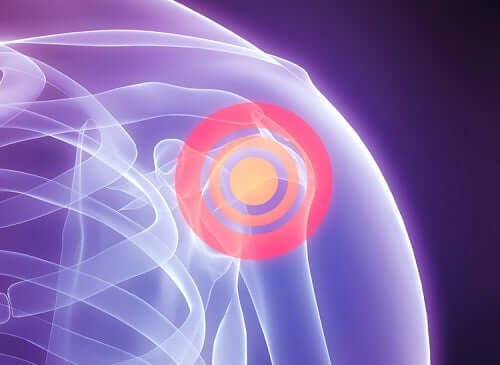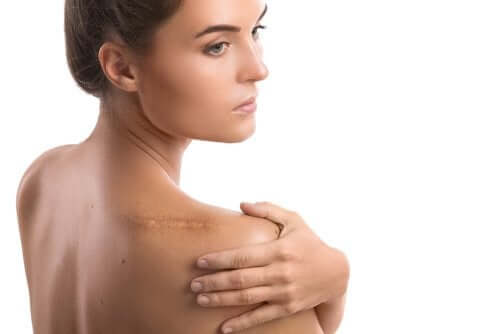Rotator Cuff Tear: Phases of Rehabilitation

A rotator cuff is a group of muscles and tendons around the shoulder joint. A rotator cuff injury can cause a dull shoulder ache, which often worsens when you try to sleep on the affected side. The risk of rotator cuff injury increases with age.
Symptoms of rotator cuff tear
Overall, pain associated with a rotator cuff injury may manifest in different ways, such as:
- Dull shoulder ache.
- Pain that disrupts sleep, especially if you sleep on the affected shoulder.
- Aches that make it hard for the affected person to comb their hair or touch their back.
- Arm weakness.
Overall, the most common way to repair a torn rotator cuff is with surgery. After, the patient needs to undergo rehabilitation. Next, we’ll take a look at what that entails.
Rotator cuff tear treatment phases

Postoperative rehabilitation after rotator cuff surgical repair should begin with close communication between the orthopedic surgeon and the rehabilitation doctor. Overall, the ideal rehabilitation program for rotator cuff tear would allow the tendon’s bone to heal and prevent shoulder stiffness.
However, each patient and rotator cuff tear is different. Therefore, any rehabilitation plan must take these differences into account to get good results.
Personalized rehabilitation
Overall, the phases of rehabilitation should be individualized for each patient, depending on:
- The type and size of the tear.
- The surgical technique used.
- Tissue quality.
- Secure repair.
- The patient’s age.
- Their activity level.
- The patient’s personal goals.
Patients with acute tears are more likely to tear again. Therefore, they must follow a slower rehabilitation protocol to protect the surgical repair. In contrast, patients with risk factors for developing postoperative shoulder stiffness require early mobilization to prevent this complication.
Also, read: How to Correct Droopy Shoulder Syndrome
Overall, the phases of rehabilitation are based on the patient’s periodic assessments. Also, this should include a home exercise program at each phase of the rehabilitation treatment.
Rotator cuff rehabilitation programs
Overall, there are two types of programs:
1. Conservative
First, the conservative program consists of a 2-4 week treatment delay to minimize tissue stress and facilitate healing. In principle, patients over 50 with acute tears, more than one tendon tear, and/or with poor tissue quality require a conservative treatment program.
2. Accelerated
On the other hand, this protocol accelerates the rehabilitation of 2-4 weeks, at no risk of damaging the repaired structures or requiring an early onset. Patients under 50 with small tears, one rotator cuff tendon tear, and good tissue quality should follow a standard or accelerated treatment program.
Also, you may enjoy: Relieve Your Shoulder Pain with These Homemade Remedies
Rotator cuff tear rehabilitation phases

Overall, there are four rehabilitation phases:
Phase 1. Immediate postoperative period
Here, the maintenance and protection of the repair in the immediate 0-4 week postoperative period include the following guidelines:
- Abduction sling/brace.
- Sleeping with the sling, in a recliner, and with a pillow under the arm.
- Remove the immobilization only for grooming and exercise.
- Cryotherapy.
- Pendulum exercises.
- Active elbow/wrist/hand range of motion exercises.
- Cervical spine stretches.
Phase 2. Protection and active motion
Next, this consists of gradually restoring the passive range of motion. Typically, this happens from weeks 4 to 10.
- At week 4, there should be an active-assisted range of motion (AAROM) in the supine position.
- After 6 weeks, there should be a full passive range of motion and initiating active assisted motion.
- At week 8, there should be scapulothoracic and submaximal isometric exercises in the closed kinetic chain and proprioceptive exercises in an open kinetic chain.
Phase 3. Early strengthening.
Next, there’s the initiation of muscle strengthening from weeks 10 to 14. Overall, the following objectives should be obtained:
- First, a full active range of motion.
- Next, restoring strength and muscular endurance.
- Also, proprioceptive and neuromuscular control.
- Additionally, periscapular strengthening muscles.
- Finally, a gradual return to daily activities.
Phase 4. Advanced strengthening
Finally, the patient is ready to return previous functionality levels. The timeline for this ranges from weeks 14 to 22. The milestones are:
- First, a complete and painless active range of motion.
- Next, a return to sports activities.
- Also, the presence of normal muscular strength and endurance.
- Finally, a return to all activities.
All cited sources were thoroughly reviewed by our team to ensure their quality, reliability, currency, and validity. The bibliography of this article was considered reliable and of academic or scientific accuracy.
-
Lech, O., Valenzuela Neto, C., & Severo, A. (2000). Tratamento conservador das lesões parciais e completas do manguito rotador. Acta Ortopédica Brasileira. https://doi.org/10.1590/S1413-78522000000300008
-
Sosa, L., & Medina, S. (2009). El Ejercicio Terapéutico , como componente clave , en el tratamiento Postoperatorio del Manguito Rotador. Canarias Médica Y Quirúrgica.
-
Magaña, M. C., Martínez, P. J., & Vidal, F. A. (2013). Diagnóstico y Tratamiento del Síndrome del Manguito Rotador. Guía De Práctica Clínica. https://doi.org/10.3406/litt.1981.1331
This text is provided for informational purposes only and does not replace consultation with a professional. If in doubt, consult your specialist.








